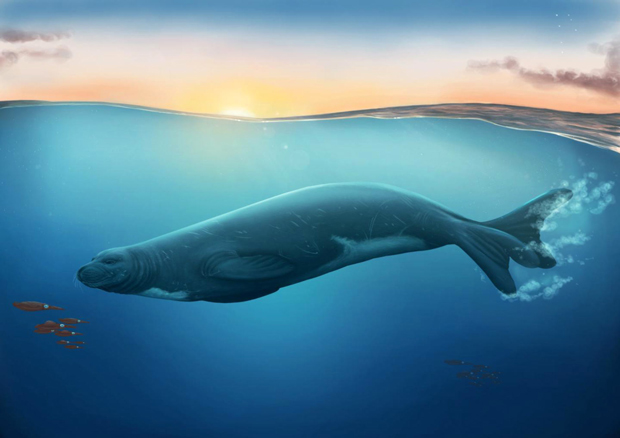New Study Seals the Fate of Pinniped Evolution
Ancient Seal from New Zealand Eomonachus belegaerensis
A team of researchers from Monash University (Victoria), the Museum of New Zealand Te Papa Tongarewa (Wellington), Canterbury Museum (Christchurch) and Museums Victoria have identified a new species of prehistoric pinniped, an ancient seal, whose discovery is helping to re-write the evolutionary history of these highly successful and diverse marine mammals.
Writing in the academic journal, the Proceedings of the Royal Society B (Biology), the scientists which include Monash University PhD student James Rule, describe a new species of monk seal that swam in the waters around New Zealand some 3 million years ago (Late Pliocene Epoch). The seal has been named Eomonachus belegaerensis, which means dawn monk seal from Belegaer. The Belegaer reference relates to the sea of Belegaer or the “Great Sea” that lay to the west of Middle Earth in J.R.R. Tolkien’s fantasy epic “Lord of the Rings”.
A Life Reconstruction of the Newly Described E. belegaerensis
Picture credit: Jaime Bran (Museum of New Zealand Te Papa Tongarewa)
Changing Views on Seal Evolution
Fossil specimens including a complete skull found by amateur fossil hunters on the Taranaki beaches (western side of North Island, New Zealand), between 2009 and 2016 led to the erection of this new species. The research team estimate that E. belegaerensis measured around 2.5 metres in length and weighed approximately 250 kilograms, about the size of an extant crabeater seal (Lobodon carcinophaga), to which Eomonachus was very distantly related.
It had been previously thought that all true seals (phocids), originated in the North Atlantic. Extant seals are split into two groups, the northern (phocine) and the southern (monachine). Only two types of monachine seal subsequently crossed the equator to inhabit the Southern Hemisphere. Those that made this migration consist of elephant seals and the lobodontins, such as the crabeater seal. The third and most basal monachine, the monk seals, had been regarded as exclusively northern throughout their entire evolutionary history.
Eomonachus belegaerensis
The discovery of the three-million-year-old fossil remains of an ancestral monk seal in New Zealand has led the researchers to conclude that today’s monk, elephant and Antarctic seals, actually evolved in the Southern Hemisphere.
This unexpected discovery reveals that all three monachine tribes once coexisted south of the equator and has led to a profound revision of pinniped evolutionary history. Rather than primarily diversifying in the North Atlantic, monachines largely evolved in the Southern Hemisphere and from this southern cradle later reinvaded the north.
Commenting on the significance of this discovery, James Rule stated:
“This new species of extinct monk seal is the first of its kind from the Southern Hemisphere. Its discovery really turns seal evolution on its head. Until now, we thought that all true seals originated in the Northern Hemisphere, and then crossed the equator just once or twice during their entire evolutionary history. Instead, many of them appear to have evolved in the southern Pacific, and then criss-crossed the equator up to eight times.”
Everything Dinosaur acknowledges the assistance of a media release from Monash University in the compilation of this article.
The scientific paper: “First monk seal from the Southern Hemisphere rewrites the evolutionary history of true seals” by James P. Rule, Justin W. Adams, Felix G. Marx, Alistair R. Evans, Alan J. D. Tennyson, R. Paul Scofield and Erich M. G. Fitzgerald published in the Proceedings of the Royal Society B.
The Everything Dinosaur website: Dinosaur Gifts and Toys.


